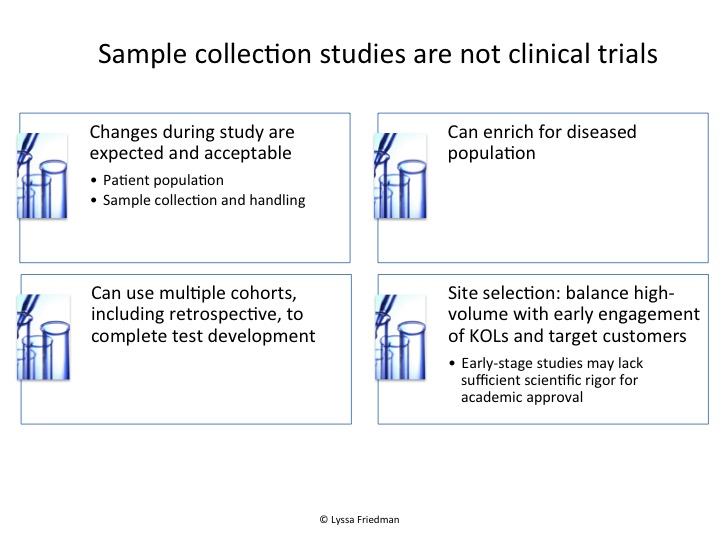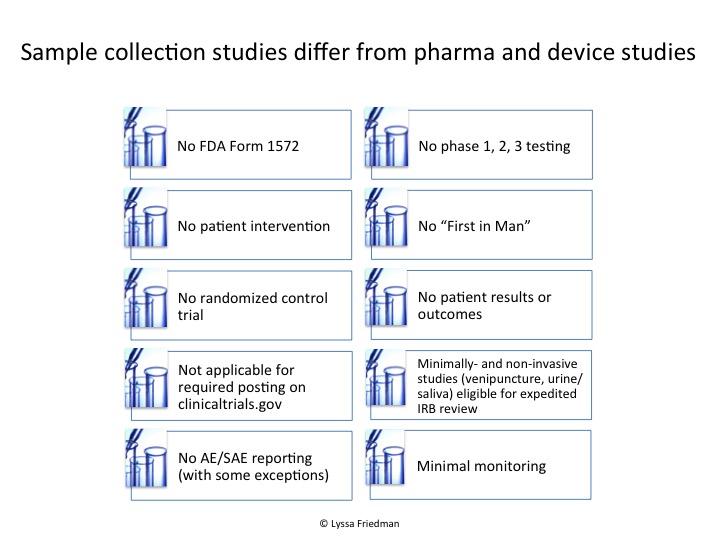To develop a diagnostic test, we need samples. Archived cohorts can be used if they are available. But when biobanks aren’t enough – because they are difficult to acquire, lack important clinical annotation or collection and handling characteristics, or because there are regulatory considerations driving the need to obtain samples from the target patient population – companies embark on the costlier and slower route of a prospective sample collection protocol.
The sample collection protocol exists to bring in samples that are collected and handled according to specifications and that carry the verifiable clinical annotation needed for development, training and testing. Although sample collection protocols have some things in common with device and drug development studies – namely, the need to comply with Good Clinical Practice regulations and the need for speed – there are many ways in which they are different. And the key difference is, where device and pharma clinical protocols are fixed before they start, sample collection protocols can change as they go.
THERE’S MORE THAN ONE WAY TO COLLECT A SAMPLE
In pharma and device studies, the endpoint is patient outcomes, and a single clinical protocol is used. Here, multiple methods of obtaining samples can be used: retrospective cohorts, sample collection protocols at different types of specialty sites and in different populations. How these samples are combined into a coherent study plan is described in a set of internal documents, the analytic and clinical validation plans.
THE INTERNAL VALIDATION PLAN IS KING, AND THE PROSPECTIVE GCP-COMPLIANT PROTOCOL IS ITS SUBJECT
These internal analytic and clinical validation plans describe what will be done with what samples under what conditions and at what timepoints. This is where the sample source, characteristics and number, the statistical plan and the disease prevalence are finalized. Although these documents are components of regulatory submissions, their contents form the foundation of intellectual property and may not be publicly shared.
ANALYSIS STARTS WHEN THE FIRST SAMPLES ARE IN – NOT WHEN THE LAST CRF IS LOCKED
Sample collection protocols are not measuring events or endpoints in human subjects; they are serving a research and development need. R&D and bioinformatics are the protocol’s masters, and those groups work with samples as they arrive. Learning is iterative and is continuously enriched as incoming samples contribute to ongoing studies.
SAMPLE SIZE CALCULATIONS ARE NOT FIXED….
A sample collection protocol is initiated with assumptions about how many samples will be needed, what clinical annotation is required, and how the samples will be collected, handled and shipped. As we learn, these assumptions may evolve. The number of samples needed rises if the disease prevalence in the study population is lower than predicted. Samples may fail due to collection and handling methods or assay stability. Extra samples may be needed to complete analytic validation studies or to manufacture controls.
… AND NEITHER IS THE STATISTICAL ANALYSIS PLAN
Diagnostic test development moves through a series of phases: discovery and feasibility, followed by training and internal verification, and ending with validation. Samples contribute to completion of each phase. Although we can open a new sample collection protocol for successive phases, it can be faster and more cost-effective to run a single sample collection protocol from start to finish. This means that the clinical sample collection protocol does not include a final statistical analysis plan; rather, there are iterative developmental phases that need samples and define expected outcomes, all of which are detailed in the internal validation plans.
THE PERFECT STUDY SAMPLE MATCHES THE TARGET COMMERCIAL SPECIMEN, BUT NOT ALL SAMPLES ARE PERFECT
It’s best if samples come from donors who represent the target commercial patient and are collected, handled and shipped as they will be once the product is launched. But perfection is not always possible. Perhaps the target population cannot be sampled during the development phase and surrogates are needed. Maybe the disease prevalence is lower in the target population and, for resource purposes, the samples are enriched by a high-prevalence group which differs from the target commercial population. Sometimes studies documenting stability of ambient shipping are not complete, and early samples are shipped frozen. Sample enrichment or use of surrogates, if done, becomes part of the clinical validation plan and regulatory submission. Sample handling gaps are filled by bridging studies, which document equivalent assay results from one sample type or collection method to the next and which become part of the analytic validation package.
THERE ARE NO PATIENT INTERVENTIONS AND NO PATIENT RESULTS
Sample collection studies offer no patient intervention. There is no disease safety monitoring board, and unless the sample collection method is high risk and outside standard care for this condition, adverse event and serious adverse event reporting may not be needed. For minimal risk sample collection such as saliva, urine, or venipuncture, expedited IRB review is possible. Because the study is underway to validate a new, not-yet-validated diagnostic test, neither patients nor their physicians receive individual test results.
PROTOCOLS ARE FLEXIBLE, NOT FIXED
In diagnostic development, the clinical protocol serves the fast-paced R&D process and must remain nimble. Change is expected, and implementation – of new clinical data needs or updated shipping techniques – is rapid. It is helpful to educate sites about the differences between sample collection protocols and those with which they likely have more experience, as mid-study changes – to sample size requirements, clinical data or sample management – will be unfamiliar.
Unfamiliar, quick, confusing, perhaps – but what fun to be on the edge of each new scientific development as a product that can change patients’ lives moves closer to launch.


